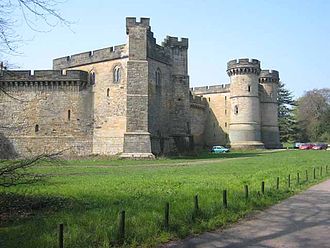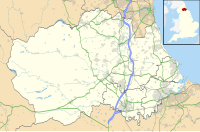Brancepeth Castle
| Brancepeth Castle | |
|---|---|
| Brancepeth | |

Brancepeth Castle from the east, showing the two 19th-century gate towers (right) and older chapel and curtain walls (centre and left)
|
|
| Coordinates | 54°44′00″N 1°39′00″W / 54.73333°N 1.65000°W |
| Site information | |
| Owner | Dobson family |
| Open to the public |
Yes but only for special events |
| Condition | Standing |
| Site history | |
| Materials | Sandstone |
Brancepeth Castle is a castle in the village of Brancepeth in County Durham, England, some 5 miles south-west of the city of Durham (grid reference NZ223377). It is a Grade I listed building.
A succession of buildings has been on the site. The first was a Norman castle built by the Bulmers, which was rebuilt by the Nevilles in the late 14th century. For many years the castle was owned by the Neville family until in 1569 it was confiscated by the Crown following the family's involvement in the Rising of the North.
There have been a number of other owners since that time. In the early 17th century the estate was granted by the Crown to Robert Carr, 1st Earl of Somerset, from whom it subsequently confiscated the castle back due to his involvement in a poisoning scandal. In 1636, three men who had bought the castle from the King's Commissioners in 1633 sold it to Ralph Cole of Newcastle. His grandson, Sir Ralph Cole MP, sold the property on 9 April 1701 to Sir Henry Belaysyse, whose daughter was involved with Bobby Shafto and who was said to have inspired the famous song. In 1796 the castle was acquired by the Russells.
The present building is largely a 19th-century restoration carried out in the 1820s by John Matthew Russell and improved in the mid-19th century by architect Anthony Salvin for William Russell, (High Sheriff of Durham in 1841). During the First World War the castle was used as a hospital by convalescents from Newcastle General Hospital. In 1939 it became the regimental headquarters for the Durham Light Infantry, who erected a military camp of over 100 huts to the south of the village during the Second World War. The Durham Light Infantry left the Castle in 1962.
...
Wikipedia

